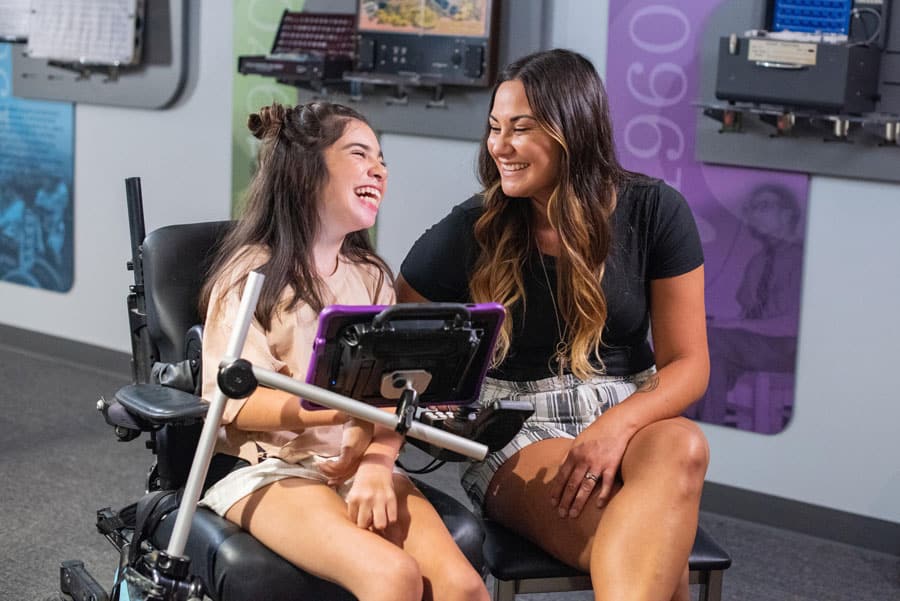
Welcome to Part 3 of our AAC myth-busting series! We’ve explored timing and speech development. Now let’s talk about something really exciting – what AAC can actually do when we think beyond ‘the basics.’
If you’ve been told AAC is mainly for requesting things, or if you’re wondering whether it’s “worth it” for more complex communication, this one’s for you. We’re about to explore just how rich and meaningful Augmentative and Alternative communication can be.
Ready to be amazed by what’s possible? Let’s dive in!
Here’s what we’ll look at today (click the myth to jump to the content):
- AAC Myth 1: “AAC is mainly for requesting things”
- AAC Myth 2: “Some speech or basic communication is enough”
- AAC Myth 3: “AAC communicators can’t have complex conversations”
- AAC Myth 4: “Communication is all about the AAC communicator’s skills”
Understanding the Full Purpose of Communication
AAC Myth 1: “AAC is mainly for requesting things”
What research shows: AAC supports all communication functions –
- commenting,
- asking questions,
- sharing experiences,
- expressing emotions,
- telling stories,
- Protesting/negating
- and building relationships.¹
While requesting is often a starting point (because it’s highly motivating and creates immediate results), this represents only a fraction of human communication. Supporting someone who is minimally speaking to ‘protest’ and say ‘no’ to something is just as essential for asking for things. This encourages personal safeguarding and gives someone real communicative power!
Think about your own conversations throughout the day. How much time do you spend asking for basic needs versus sharing experiences, making jokes, or connecting with others?
The reality: Communication serves four main purposes and AAC communicators deserve access to ALL of them….
The Four Purposes of Communication
Researcher Janice Light discusses four fundamental reasons we communicate – and AAC should support all of them:²
1. Wants and Needs
This includes basic needs (food, comfort, assistance), personal preferences (favourite activities, entertainment, breaks), objects, and choice-making.
2. Information Sharing
Sharing knowledge, giving directions, answering questions, explaining how things work, providing updates about events. This makes up much of our daily communication at work, school, and home.
3. Social Connection
From greetings and sharing stories, to offering comfort, and making jokes. These social interactions help navigate public spaces and maintain relationships.
4. Protesting & Negating
identifying what you DON’T want or behaviour you’re trying to stop can help create safe spaces and encourage healthy boundaries.
The reality: If AAC focuses only on requesting, we’re limiting people to just one-quarter of human communication.
Moving Beyond “Basic Needs” Thinking
AAC Myth 2: “Some speech or basic communication is enough”
What research shows: Functional communication means being able to participate fully in all areas of life – social, educational, vocational, and personal.³
We need to ask crucial questions:
- Does their current communication meet their needs?
- Does it enable them to learn and develop language and literacy skills?
- Can they build and maintain relationships?
- Are they able to share their thoughts, experiences, and personality?
The reality: “Getting basic needs met” is the minimum standard for survival, not the goal for human flourishing. By giving people a system that only allows them to communicate their basic needs, we are establishing an artificial limit.
When this happens, we are taking away their language learning opportunities and ability to communicate for different ways and for more advanced reasons with more linguistic complexity.
AAC Supports Complex Communication
AAC Myth 3: “AAC communicators can’t have complex conversations”
What research shows: Modern AAC systems provide access to…
– Core vocabulary: High-frequency words like “think,” “different,” “because,” “maybe” that work across many situations
– Fringe vocabulary: Specific nouns, places, people’s names for detailed conversations
– Grammar tools: Word endings, sentence starters, conjunctions for complex language
– Social phrases: Conversation starters, expressions of empathy, humour
– Personal Safeguarding: Words and phrases for protesting and negating, like “I don’t like…”, “that’s not right…” and “this doesn’t meet my needs.”

The reality: With appropriate vocabulary access and responsive communication partners, AAC communicators can engage in sophisticated communication across all contexts.⁴
The Role of Communication Partners
AAC Myth 4: “Communication is all about the AAC communicator’s skills”
What research shows: Communication is always a two-way process. Responsive communication partners are essential for interactions.⁵
Effective communication partners:
- Listen with patience: Give time for message construction without rushing
- Respond to meaning: Focus on what’s being communicated, not how long it takes
- Ask genuine questions: Show real interest in thoughts and experiences
- Model language: Use AAC systems themselves during conversations
- Presume competence: Believe in the person’s ability to communicate meaningfully
- Are open to negation: encourage the person to establish their preferences, to set boundaries, to say no if they don’t like something and encourage them to stand up for what they want.
- Are present: focus on connecting, observing, and just being with the AAC communicator as a priority.
The reality: When communication partners are engaged and responsive, rich conversations flourish. Communication barriers often result from partner factors, not AAC limitations.
Moving Forward
Here’s what we love about supporting comprehensive AAC: every time we expand what’s possible, we discover that people have so much more to say than anyone realised.

When we move beyond just “getting needs met” and start supporting full, rich communication, amazing things happen.
If you’re just starting out, don’t feel like you need to implement everything at once. Start with one area that excites you, your child or your client – maybe storytelling if they love books, or social chat if they’re naturally social. Build from there!
For our fellow professionals: remember that meaningful communication assessment includes all these functions, not just requesting. When we support the full scope of human communication, we see the full scope of human potential.
Coming up next…
Part 4 will explore technology choices and why you don’t need to start with “simple” tools before accessing robust communication systems.
Ready to explore comprehensive communication? Contact our team today to discover how AAC can support fuller, richer communication for you or your loved one.
Interested in learning more about AAC? Join one of our upcoming workshops or training events. Check out our full calendar here. You can also find AAC implementation resources at the Centre for AAC & Autism website.
References:
¹ Light, J., & McNaughton, D. (2014). Communicative competence for individuals who require augmentative and alternative communication: A new definition for a new era of communication? Augmentative and Alternative Communication, 30(1), 1-18.
² Light, J. (1996). Communication is the essence of human life. Augmentative and Alternative Communication, 13, 61-70.
³ Hanson, Elizabeth. (2014). My Client Talks! Do I Still Need to Consider AAC in my Treatment Planning? Perspectives on Augmentative and Alternative Communication, 23, 124-131.
⁴ Soto, G., & Clarke, M. T. (2017). Effects of a conversation-based intervention on the linguistic skills of children with motor speech disorders who use augmentative and alternative communication. Journal of Speech, Language, and Hearing Research, 60(7), 1980-1998.
⁵ Kent-Walsh, J., & McNaughton, D. (2005). Communication partner instruction in AAC: Present practices and future directions. Augmentative and Alternative Communication, 21(3), 195-204.
